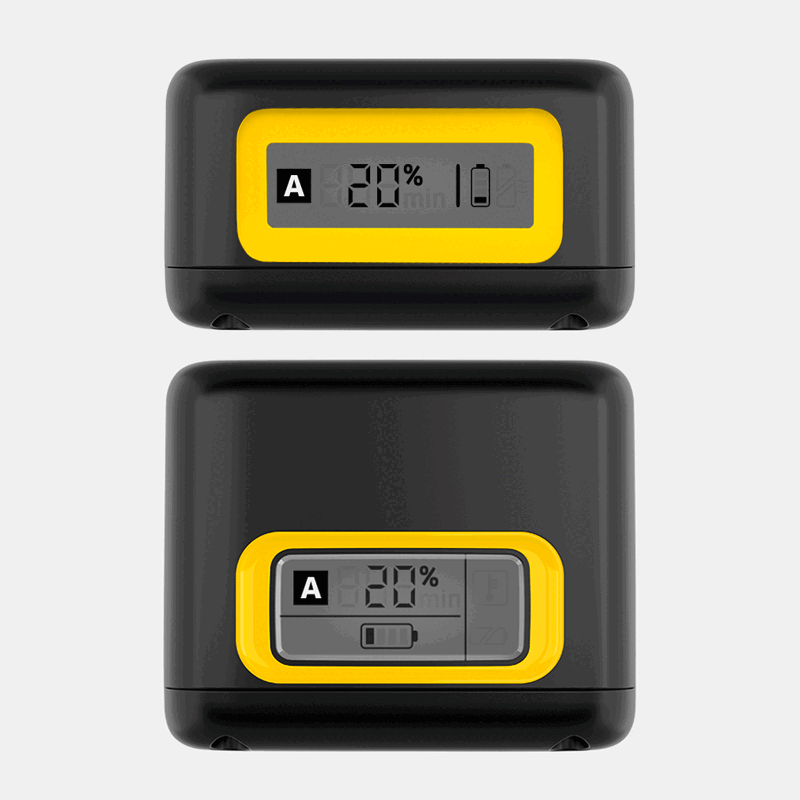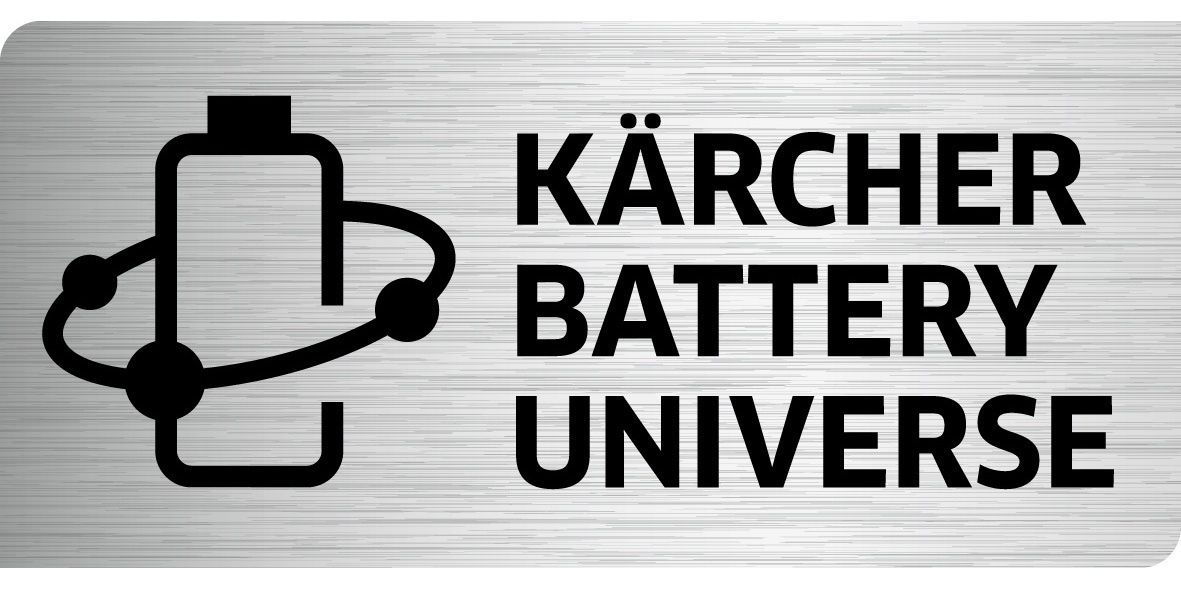Kärcher exchangeable battery FAQs
How long is the battery run time? Which batteries are compatible with which devices? How does Kärcher Real Time Technology work? Answers to these and other questions about the Kärcher exchangeable battery platforms for battery-powered devices can be found here in the Frequently Asked Questions.
General
- Versatile fields of application: An exchangeable battery can be used in several devices of a battery platform. This saves costs in the long term and protects resources as a battery does not need to be purchased for each device.
- Maximum flexibility and freedom of movement: Without any annoying power cable. Charging is also possible independent of the device storage.
- Work until everything is clean: The battery run time can be extended considerably with the use of several batteries.
- More compact, more powerful and packed with the latest features: Our customers benefit from the advancing battery and device technology.
During use the Kärcher Real Time Technology shows the user the remaining running time of the respective device via a built-in display. Plugged in to the battery charger, the display also indicates the remaining charging time. If the battery is not in use or in the battery charger, the remaining capacity is displayed as a percentage.
In order to guarantee an optimal calculation of the running time, Kärcher recommends initially charging a new battery to 100% and then allowing it to fully discharge during use until the device switches off. By doing this the battery adjusts and the display of the Real Time Technology works properly.
Battery Power:
18 V / 2.5 Ah
18 V / 5.0 Ah
36 V / 2.5 Ah
36 V / 5.0 Ah
Battery Power+:
18 V / 3.0 Ah
36 V / 6.0 Ah
36 V / 7.5 Ah

Kärcher offers two platforms in order to meet the different requirements and needs of our customers.
The 18 V Kärcher battery platform comprises compact and handy products for caring for and cleaning small and medium-sized gardens and surfaces such as hard surfaces and textile coverings.
For large areas the 36 V Kärcher battery platform offers powerful devices in various categories. These devices are suited in particular to gardening work, professional garden maintenance and cleaning in the house, hotel, on construction sites or in public buildings and facilities.
No, this is not possible. The batteries are coded, meaning 18 V batteries can only be used in 18 V devices and not in a 36 V device. The same applies to 36 V batteries and 36 V devices. Many battery chargers can charge both 18 V and 36 V batteries. This is then indicated separately.
Yes, all devices and batteries from Kärcher are compatible with each other within a voltage class. This means that an 18 V Battery Power- device can also be operated with an 18 V Battery Power+ battery.

Battery Power+ batteries are designed for professional use, Battery Power- batteries are suitable for private users. The two batteries have different colours: The Battery Power- batteries are yellow, whereas the Battery Power+ batteries are anthracite. As the batteries are generally used less regularly for private use, the Battery Power- batteries have an automatic storage mode. This function protects the battery cells against premature ageing and increases the lifetime: The storage mode is activated and discharges the battery pack to 70% if it has not been used for more than 21 days. All Battery Power+ batteries as well as the 36 V Battery Power- batteries have a soft grip, this ensures a firm hold and no slipping on smooth and uneven surfaces. Battery Power+ batteries also provide extended communication options and higher capacities.
No, there is no technical difference here. From a technical point of view, 20 V batteries correspond to 18 V batteries and 40 V batteries to 36 V batteries. According to a manufacturer agreement, most manufacturers have agreed to indicate the voltage as it corresponds to the nominal cell voltage. A typical lithium-ion battery cell has a nominal voltage of approx. 3.6 V. This means that a battery with 5 such cells has 18 V nominal voltage; a battery with 10 such cells has 36 V. 20 V and 40 V are merely marketing values.
A higher voltage rating means that the device is more powerful. Depending on the application, this can be an advantage, but it's impossible to tell if a higher voltage rating is always better. Apart from the voltage, with battery-operated devices other parameters such as the running time and the device weight (incl. battery) are also relevant. To that effect, the capacity or the energy must also always be considered in watt-hours, which is calculated from the voltage in Volt multiplied by the capacity in Ah. The 18 V and 36 V devices from Kärcher are perfectly adapted to the different applications and individual needs of the customers.
Running times
Overview of all battery-operated devices and running times
DownloadOverview of all battery-operated devices and running times
DownloadCharging times
Charging times with the Battery Power 18 V quick charger:
Platform: 18 V
Charging current: 2.5 A
Charging times:
18 V / 2.5 Ah: 80%: 44 mins, 100%: 83 mins
18 V / 3.0 Ah: 80%: 56 mins, 100%: 81 mins
18 V / 5.0 Ah: 80%: 94 mins, 100%: 143 mins
Charging times with the Battery Power 36 V quick charger:
Platform: 36 V
Charging current: 2.5 A
Charging times:
36 V / 2.5 Ah: 80%: 48 mins, 100%: 78 mins
36 V / 5.0 Ah: 80%: 98 mins, 100%: 138 mins
36 V / 6.0 Ah: 80%: 108 mins, 100%: 148 mins
36 V / 7.5 Ah: 80%: 139 mins, 100%: 190 mins
Charging times with the universal battery charger:
Platform: 18 V and 36 V
Charging current: 6 A
Charging times:
18 V / 2,5 Ah: 80%: 32 mins, 100%: 63 mins
18 V / 3,0 Ah: 80%: 40 mins, 100%: 63 mins
18 V / 5,0 Ah: 80%: 39 mins, 100%: 63 mins
36 V / 2,5 Ah: 80%: 35 mins, 100%: 60 mins
36 V / 5,0 Ah: 80%: 40 mins, 100%: 68 mins
36 V / 6,0 Ah: 80%: 45 mins, 100%: 76 mins
36 V / 7,5 Ah: 80%: 58 mins, 100%: 92 mins
Charging times with the Battery Power+ 18 V quick charger:
Platform: 18 V
Charging current: Max. 6 A
Charging times:
18 V / 3.0 Ah: 80%: 40 mins, 100%: 63 mins
18 V / 5.0 Ah: 80%: 39 mins, 100%: 63 mins
Charging times with the Battery Power+ 36 V fast quick charger:
Platform: 36 V
Charging current: Max. 6 A
Charging times:
36 V / 5.0 Ah: 80%: 40 mins, 100%: 68 mins
36 V / 6.0 Ah: 80%: 45 mins, 100%: 76 mins
36 V / 7.5 Ah: 80%: 58 mins, 100%: 92 mins
Charging times with the universal charger Battery Power+:
Platform: 18 V und 36 V
Charging current: Max. 6 A
Charging times:
18 V / 3.0 Ah: 80%: 40 mins, 100%: 63 mins
18 V / 5.0 Ah: 80%: 39 mins, 100%: 63 mins
36 V / 5.0 Ah: 80%: 40 mins, 100%: 68 mins
36 V / 6.0 Ah: 80%: 45 mins, 100%: 76 mins
36 V / 7.5 Ah: 80%: 58 mins, 100%: 92 mins
The charging time is not linear. After approximately two thirds of the time the battery is roughly 80% charged and can be used. An excessive amount of time is required for the last 20%. This is necessary in order to protect the cells against overvoltage and overcharging and thus increase the lifetime. If pressed for time, Kärcher recommends only charging the battery to 80% and then using the device.
Lifetime
The lifetime is dependent on various external factors, including the device used, the temperature during use, storage, charging and charging behaviour. The durability of our batteries is perfectly adapted to use with our battery platform devices.
Cells are used which Kärcher has selected to meet the highest quality standards and performance demands. The automatic storage mode (only with Battery Power) is designed so that it extends the lifetime of the batteries. In addition, all batteries have efficient temperature management as well as intelligent cell monitoring. This also has a positive effect on the lifetime.
Do not store the battery with 0% capacity (i.e. completely dead), but charge up before storage (ideally to 70%). Kärcher Battery Power- batteries have an automatic storage mode, which automatically discharges the battery to 70% after 21 days of non-use , thus increasing the lifetime of the cells.
In addition, the battery should only be stored, charged and used at the specified temperature range: operating temperature from −20 to 40 °C; charging temperature from 4 to 40 °C, storage temperature from −20 to 60 °C. There is also a positive effect when the battery is stored below 20 °C and in a dry place.
First use
Before the initial startup the battery pack is in sleep mode, the first charging process activates the display. New battery packs from Kärcher are only precharged and must be fully charged before their first use.
They reach full capacity after approximately 5 charging and discharging cycles.
Figure A
Storing the battery pack: When not in use, the display shows the charging state of the battery pack as a percentage.
Figure B
Using the battery pack: During use the display shows the remaining running time of the battery pack in minutes.
Figure C
Charging the battery pack: During the charging process the display shows the remaining running time of the battery pack in minutes.
Figure D
Charging the battery pack: The display indicates when the battery pack is fully charged.
Figure E
Error indication: The display indicates when the battery pack temperature is outside the permissible temperature range or if there is a short circuit. The symbol goes out as soon as the battery is ready for use again.
Figure F
Error indication: The display indicates that the battery pack is defective and is disabled for safety reasons. The battery cannot be recharged and must be disposed of immediately.

Charging
The charging temperature should be between 4 and 40 °C.
Partially discharged batteries can also be charged and the battery can be removed before the 100% charge, without memory effect.
Kärcher universal battery chargers can charge both 18 V and 36 V batteries. All other battery chargers are only designed for a special voltage class. The suitability is always clearly stated on the battery charger.
Storage and care
The Kärcher Battery Power- and Battery Power+ batteries should be stored between −20 and maximum 60 °C. Ideally the battery is charged to at least 70% before long periods of storage. Only store battery packs in a dry place indoors with low humidity and below 20 °C.
Kärcher Battery Power- batteries have an automatic storage mode, which is activated and discharges the battery pack to 70% when the battery pack has not been used for more than 21 days. This function protects the battery cells against premature ageing and increases the lifetime.
If the battery was charged to at least 70% before storage, there is no risk of a deep discharge, even over a period of years. In this case occasional recharging is not necessary.
The battery should not be stored in the device or plugged in to the battery charger. If the fully charged battery pack remains in the battery charger until use, there is no risk of overcharging. However, unnecessary energy use should be avoided. Therefore, it is recommended to unplug the battery charger when the battery pack is fully charged. Also note the information in the instruction manual with regard to storage.
The display requires approx. 1% capacity per month. For comparison: The natural self-discharge of a battery without display is approx. 0.5% per month. If the battery state is too low, then the display goes out and protects the battery pack against a deep discharge.
Warranty, repair and disposal
The warranty conditions are country-dependent. Always obtain the relevant information in the Service section on the respective country site.
Battery packs and battery chargers do not require any maintenance and cannot be repaired. Defective battery packs and battery chargers must be disposed of immediately in accordance with the applicable national regulations. If the removable power supply of the battery charger is defective, it can be exchanged.
Special disposal regulations apply to batteries owing to the materials they contain. These regulations may differ depending on the country. Therefore, please obtain information on the applicable regulations for the disposal of batteries in the respective country and act accordingly. Battery chargers must be disposed of as electronic equipment. As a rule of thumb: Batteries and battery chargers cannot be disposed of in household waste.
Safety and functionality
The Kärcher Battery Power- and Battery Power+ batteries have integrated intelligent cell monitoring, which protects the battery against overloading, overheating and deep discharge.
The following temperature ranges apply to the use and storage of the battery packs:
Charging: between 4°C and 40 °C.
Use: between 0 °C and 40 °C
Storage: between −20 and 60 °C, whereby we recommend storing below 20 °C.
In addition, batteries must always be stored in a dry place. High temperatures have a negative effect on the lifetime of the battery pack.
Heat is generated during the charging process and therefore it is normal that the battery and the battery charger heat up during the charging process. If the temperature becomes too high, the temperature symbol appears on the battery display and the charging process is interrupted. As soon as the temperature returns to the normal range, the battery pack is automatically charged again.
Kärcher Battery Power- and Battery Power+ batteries have high-performance lithium-ion cells. These guarantee consistent power with low self-discharge and no memory effect. The latter occurred in the previous technology with nickel cadmium cells (NiCd).
No, due to the voltage monitoring of the individual cells it is not possible to overcharge the battery during the charging process. The intelligent cell monitoring switches the battery off beforehand and protects it against overcharging.
Due to the voltage monitoring of the individual cells a deep discharge of the battery is not possible during the application. The intelligent cell monitoring switches the battery off beforehand and protects it against a deep discharge. In this case the display on the battery pack shows 0 minutes or 0%.
We recommend charging the battery before storage. By doing this there is no risk of a deep discharge - even over very long periods of several years.
Help with faults
In the instruction manuals you can look up all details in the "Help with faults" section. This can also be viewed online in the Service section and directly at the product. If your issues cannot be clarified here, please contact our customer services department at any time.
If the battery is almost empty, the display is switched off and protects the battery against a deep discharge. The battery can still be stored for several months in this state. Kärcher recommends charging the battery before storage and after every use. This has a positive effect on the lifetime of the battery. If the display goes off, it can be reactivated by plugging the battery into the battery charger and charging the battery. If, in this case, the display does not come on after 2 minutes, then the battery is defective and must be disposed of immediately in accordance with national regulations.
Kärcher Battery Power- and Battery Power+ batteries display the "Defect symbol" in the event of a defect. The display can completely go out after some time. If the display cannot be activated within 2 minutes of the battery being connected to the battery charger, then the battery is defective and must be disposed of in accordance with regulations. Please note the relevant national regulations.

Battery Universe
Whether 18 V, 36 V, Battery Power or Battery Power +: Here you find comprehensive information on the advantages, features and compatibility of the exchangeable battery systems from Kärcher.


